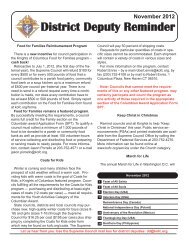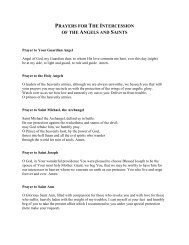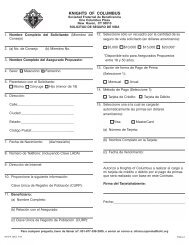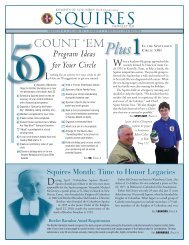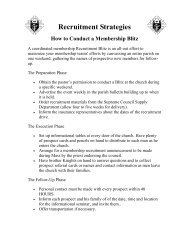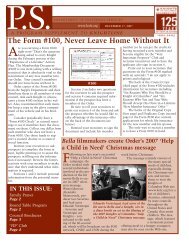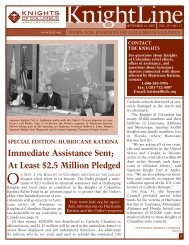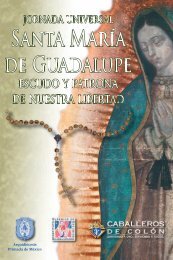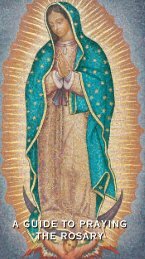Revelation: - Knights of Columbus, Supreme Council
Revelation: - Knights of Columbus, Supreme Council
Revelation: - Knights of Columbus, Supreme Council
Create successful ePaper yourself
Turn your PDF publications into a flip-book with our unique Google optimized e-Paper software.
In vv. 10-11 we read that the seven heads are also seven kings, five <strong>of</strong> whom<br />
have fallen, one is, the other has not yet come, and when he comes, he must remain only<br />
a little while. As for the beast that was and is not, it is an eighth but it belongs to the<br />
seven, and it goes to perdition. Probably what John means is this. He had the beast<br />
with seven heads from Daniel, and he has not changed the figure. He is<br />
thinking, however, <strong>of</strong> eight emperors <strong>of</strong> Rome. These are the eight that have<br />
ruled down to his time, who were Augustus, Tiberius, Caligula, Claudius,<br />
Nero, Vespasian, Titus, and Domitian (there were three others, Vitellius,<br />
Galba, and Otho, who had reigned only mo mentarily, however). Five <strong>of</strong> these<br />
had fallen – the Church had seen the end <strong>of</strong> the persecution <strong>of</strong> Nero. One is –<br />
John puts himself in the time <strong>of</strong> Vespasian (when the vision may originally<br />
have been granted), during whose reign there was a temporary surcease from<br />
persecution. One is yet to be – Titus, who destroyed Jerusalem, and who<br />
reigned a relatively short time. The eighth, who is one <strong>of</strong> the seven, is<br />
Domitian, whom the early Christians, as we know from the writings <strong>of</strong><br />
Tacitus, Dio Cassius, and Dio Chrysostom, along with others, pic tured as a<br />
reincarnation <strong>of</strong> Nero. It is in this sense also that we should understand 13:3,<br />
<strong>of</strong> the wounding <strong>of</strong> one <strong>of</strong> the heads <strong>of</strong> the beast, only for it to be re stored.<br />
Also, in view <strong>of</strong> this explanation now given, we see the reason for the<br />
description <strong>of</strong> the dragon in 12:3.The dragon, who is Satan, exercises his<br />
power through the beast.<br />
The ten kings <strong>of</strong> 17:12 given as an explanation <strong>of</strong> the ten horns <strong>of</strong> the beast<br />
probably refer to the other kings <strong>of</strong> the earth who, in John’s time, shared in<br />
the power <strong>of</strong> Rome, though only partly, for one hour. They, too, make up the<br />
world that is opposed to Christ and assist in the persecution <strong>of</strong> the Church<br />
(vv. 13-14). But eventually they and the beast will turn against Rome and<br />
destroy her (vv. 15-18). John not only predicts the destruction <strong>of</strong> the Roman<br />
Empire, by pic turing the beast which previously has been described in terms<br />
<strong>of</strong> that very empire now in opposition to it, he shows that he does not see the<br />
power <strong>of</strong> antichrist simply iden tified with Rome. It is a power that continues<br />
and that will outlive Rome.<br />
Fall <strong>of</strong> Babylon<br />
(<strong>Revelation</strong> 18-19)<br />
Chapter 18 consists first <strong>of</strong> a proclamation <strong>of</strong> the ruin <strong>of</strong> Babylon (vv. 1-8),<br />
a tissue <strong>of</strong> quotations from Isaiah and Jeremiah chiefly, in this order: Jeremiah<br />
- 51 -




